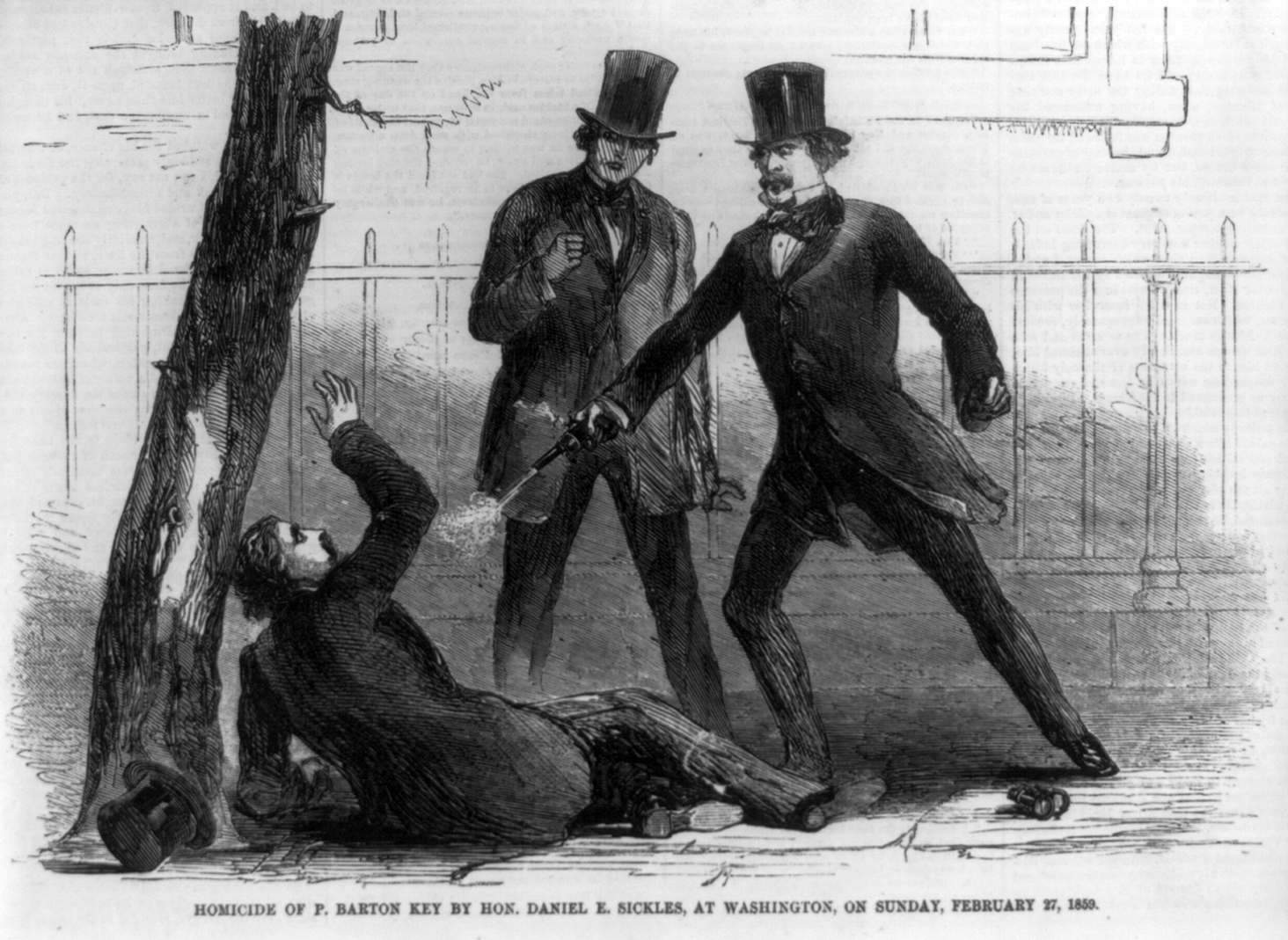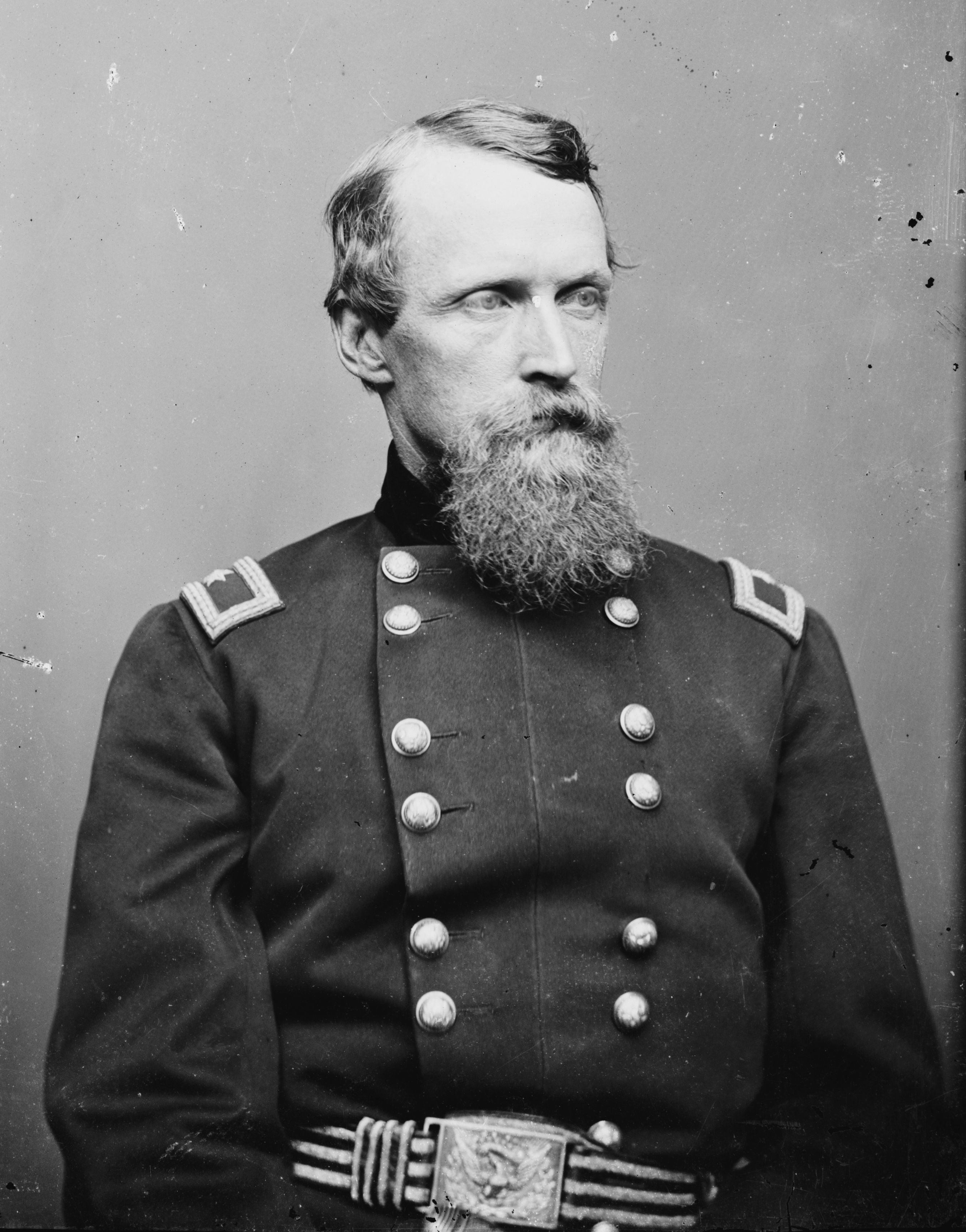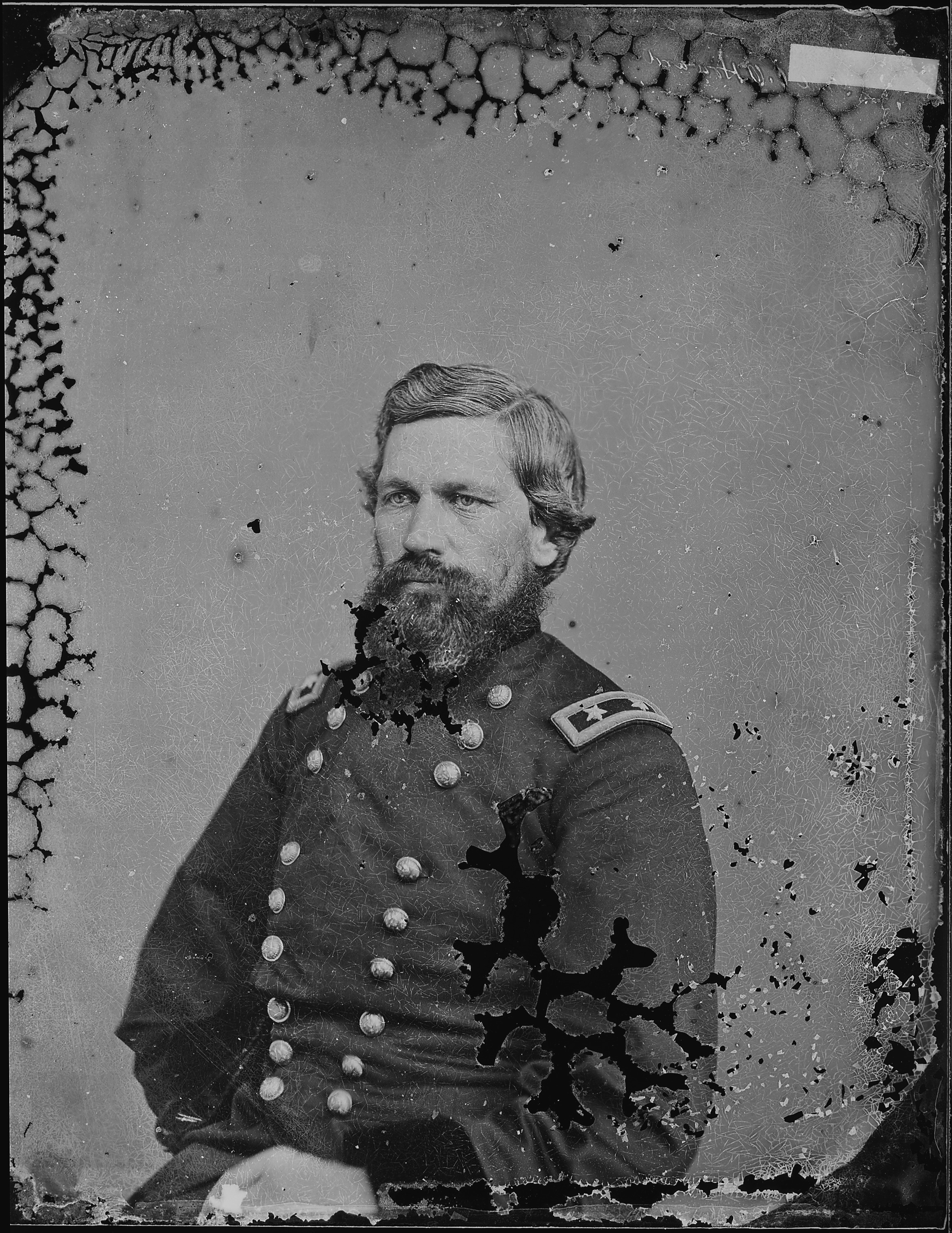|
Hiram G. Berry
Hiram Gregory Berry (August 27, 1824 – May 3, 1863) was an American politician and general in the Army of the Potomac during the American Civil War. Birth and early years Hiram Gregory Berry was born on August 27, 1824 on his parents' farm in the Meadows of Thomaston (now the City of Rockland), Maine. He was the fourth child of Frances Gregory Berry and Jeremiah Berry. He had 3 brothers and one sister. Hiram G. Berry was born in Rockland, Maine, where he worked as a carpenter and a navigator. He served several terms in the State Legislature and subsequently became the mayor of Rockland. He also originated and commanded the "Rockland Guard," a volunteer militia company, which held a reputation for drill and discipline. On April 21, 1852, Hiram co-founded the Rockland Steam Manufacturing Company along with I. K. Kimball, A. H. Kimball, and Joseph C. Libby. The company created doors, sashes, and blinds. Its buildings, however, caught fire in 1855 and were destroyed. After bei ... [...More Info...] [...Related Items...] OR: [Wikipedia] [Google] [Baidu] |
Thomaston, Maine
Thomaston (formerly known as Fort St. Georges, Fort Wharf, Lincoln) is a town in Knox County, Maine, United States. The population was 2,739 at the 2020 census. Noted for its antique architecture, Thomaston is an old port popular with tourists. The town was named after Major General John Thomas. History As early as 1630, a trading post was established on the eastern bank of the St. George River, then considered the boundary between New England and New France. In 1704, Thomas LeFebvre from Quebec bought a large tract of land along the Weskeag River on which he built a gristmill, with a house on the shoreline at what is now South Thomaston. The area became known as Thomas' Town. In 1719–1720, the old trading post was remodeled into Fort St. George, a stockaded fort protected by two blockhouses. But Abenaki Indian tribes protested the encroachment of an English fort on their territory. Instigated by the French, they attacked the garrison twice during Dummer's War in 1722, ... [...More Info...] [...Related Items...] OR: [Wikipedia] [Google] [Baidu] |
Army Of The Potomac
The Army of the Potomac was the principal Union Army in the Eastern Theater of the American Civil War. It was created in July 1861 shortly after the First Battle of Bull Run and was disbanded in June 1865 following the surrender of the Confederate Army of Northern Virginia in April. History The Army of the Potomac was created in 1861 but was then only the size of a corps (relative to the size of Union armies later in the war). Its nucleus was called the Army of Northeastern Virginia, under Brig. Gen. Irvin McDowell, and it was the army that fought (and lost) the war's first major battle, the First Battle of Bull Run. The arrival in Washington, D.C., of Maj. Gen. George B. McClellan dramatically changed the makeup of that army. McClellan's original assignment was to command the Division of the Potomac, which included the Department of Northeast Virginia under McDowell and the Department of Washington under Brig. Gen. Joseph K. Mansfield. On July 26, 1861, the Department of the S ... [...More Info...] [...Related Items...] OR: [Wikipedia] [Google] [Baidu] |
Gershom Mott
Gershom Mott (April 7, 1822 – November 29, 1884) was a United States Army officer and a General in the Union Army, a commander in the Eastern Theater of the American Civil War. Early life General Mott was born in Lamberton, New Jersey, a town outside of Trenton. He was the grandson of American Revolutionary War Captain John Mott, who guided General George Washington’s army down the Delaware River to the celebrated victory at the Battle of Trenton. The reliability of this claim has recently come under question. His parents were Gershom and Phebe (or Phoebe) Rose Scudder Mott.Heidler, p. 1369. Gershom Mott was the youngest of five children. He received his education at the Trenton Academy, which is now the Trenton Public Library (Main Branch). Gershom Mott began to work when he was only fourteen years old as a sales clerk in a dry goods store in New York City. He became a second lieutenant in the 10th U.S. Infantry during the Mexican–American War. On August 8, 1849, Gersho ... [...More Info...] [...Related Items...] OR: [Wikipedia] [Google] [Baidu] |
Daniel Sickles
Daniel Edgar Sickles (October 20, 1819May 3, 1914) was an American politician, soldier, and diplomat. Born to a wealthy family in New York City, Sickles was involved in a number of scandals, most notably the 1859 homicide of his wife's lover, U.S. Attorney Philip Barton Key II, whom Sickles gunned down in broad daylight in Lafayette Square, across the street from the White House. He was acquitted after using temporary insanity as a legal defense for the first time in United States history. Upon the outbreak of the American Civil War in 1861, Sickles became one of the war's most prominent political generals, recruiting the New York regiments that became known as the Excelsior Brigade in the Army of the Potomac. Despite his lack of military experience, he served as a brigade, division, and corps commander in some of the early Eastern campaigns. His military career ended at the Battle of Gettysburg in July 1863, after he moved his III Corps without orders to an untenable position ... [...More Info...] [...Related Items...] OR: [Wikipedia] [Google] [Baidu] |
III Corps (ACW)
There were four formations in the Union Army designated as III Corps (or Third Army Corps) during the American Civil War. Three were short-lived: *In the Army of Virginia, a temporary designation of the command better known as I Corps (Army of the Potomac):: **Irvin McDowell (June 26 – September 5, 1862); **James B. Ricketts (September 5–6, 1862); **Joseph Hooker (September 6–12, 1862) *In the Army of the Ohio: ** Charles C. Gilbert (September 29 – October 24, 1862) *In the Army of the Cumberland: ** Charles C. Gilbert (October 24 – November 5, 1862) The other, the III Corps, Army of the Potomac (March 13, 1862 – March 24, 1864), is the subject of this article. Corps history The III Corps included in its organization the famous Kearny Division; also, Hooker's Division, the Excelsior Brigade, the Second Jersey Brigade, and other well known commands. Its brilliant record is closely interwoven with the history of the Virginia campaigns of 1 ... [...More Info...] [...Related Items...] OR: [Wikipedia] [Google] [Baidu] |
37th New York Volunteer Infantry Regiment
The 37th New York Infantry Regiment or the Irish Rifles was formed accepted by the State on May 25, 1861, and organized in New York City. The regiment mustered in the service of the United States on June 6 and 7, 1861 for two years of service to June 22, 1863. The 75th New York Militia formed the nucleus of the regiment. Several companies were recruited: H at Allegany, I at Ellicottsville, K at Pulaski, and all others at New York City. Men from the 101st New York Volunteer Infantry joined this regiment by transfer on December 24, 1862. An on May 25, 1863, men who had served were consolidated into two companies and these were transferred to the 40th Infantry as Companies I and K. Service The 37th New York had its roots in the 75th New York State Militia, organized in 1856 by John H. McCunn, colonel; James Haggerty, lieutenant colonel; and Dennis C. Minton, major. The 75th was disbanded in 1856, but was revived in April 1861 when President Abraham Lincoln issued his call to arm ... [...More Info...] [...Related Items...] OR: [Wikipedia] [Google] [Baidu] |
5th Michigan Volunteer Infantry Regiment
The 5th Michigan Infantry Regiment was an infantry regiment from Michigan that served in the Union Army during the American Civil War. The regiment was mustered into federal service in August 1861 and served in the Eastern Theater. It fought in all the major battles of the Army of the Potomac, including Seven Pines, the Seven Days Battles, Second Bull Run, Chantilly, Antietam, Fredericksburg, Chancellorsville, Gettysburg, the Wilderness, Spotsylvania, Cold Harbor, Petersburg, and Appomattox. The regiment was mustered out in June 1865. Service The 5th Michigan Infantry was organized at Detroit, Michigan and mustered into Federal service for a three-year enlistment on August 28, 1861. In October 1862 the Army of the Potomac was reorganized. The 5th Michigan, along with the 17th Maine Volunteer Infantry Regiment, was placed in the 3rd Brigade, 1st Division, 3rd Corps. "Our regiment is assigned to the 3rd Brigade, 1st Division, III Corps (Union Army). This Brigade is command ... [...More Info...] [...Related Items...] OR: [Wikipedia] [Google] [Baidu] |
3rd Michigan Volunteer Infantry Regiment
The 3rd Michigan Infantry Regiment was an infantry regiment that served in the Union Army during the American Civil War. Commanders * Colonel Daniel McConnell * Colonel Stephen Gardner Champlin * Colonel Byron Root Pierce See also * 3rd Michigan Volunteer Infantry Regiment (reorganized) * List of Michigan Civil War Units *Michigan in the American Civil War Michigan made a substantial contribution to the Union during the American Civil War. While the state itself was far removed from the combat theaters of the war, Michigan supplied many troops and several generals, including George Armstrong Cus ... Notes External linksThird Michigan Infantry Research Project {{DEFAULTSO ... [...More Info...] [...Related Items...] OR: [Wikipedia] [Google] [Baidu] |
2nd Michigan Volunteer Infantry Regiment
The 2nd Michigan Infantry Regiment was an infantry regiment that served in the Union Army during the American Civil War. Service The 2nd Michigan Infantry was organized by Francis William Kellogg and others at Fort Wayne in Detroit, Michigan. It mustered into Federal service for a three-year enlistment on May 25, 1861. Another key early supporter and recruiter was future general Israel B. Richardson. The regiment included Sarah Emma Edmonds (aka "Franklin Thompson") who had enlisted in Company F disguised as a man. Anna Etheridge served as the regimental vivandiere. The regiment was mustered out on August 1, 1865, at Detroit. Total strength and casualties The regiment suffered 11 officers and 214 enlisted men who were killed in action or mortally wounded and 4 officers and 143 enlisted men who died of disease, for a total of 372 fatalities.http://www.civilwararchive.com/Unreghst/unmiinf1.htm The Civil War Archive website after Dyer, Frederick Henry. A Compendium of the War ... [...More Info...] [...Related Items...] OR: [Wikipedia] [Google] [Baidu] |
Brigadier General (United States)
In the United States Armed Forces, a brigadier general is a one-star general officer in the United States Army, Marine Corps, Air Force, and Space Force. A brigadier general ranks above a colonel and below a major general. The pay grade of brigadier general is O-7. It is equivalent to the rank of rear admiral (lower half) in the other United States uniformed services which use naval ranks. It is abbreviated as BG in the Army, BGen in the Marine Corps, and Brig Gen in the Air Force and Space Force. History The rank of brigadier general has existed in the U.S. military since the inception of the Continental Army in June 1775. To prevent mistakes in recognizing officers, a general order was issued on July 14, 1775, establishing that brigadier generals would wear a ribbon, worn across the breast, between coat and waistcoat, pink in color. Later, on June 18, 1780, it was prescribed that brigadier generals would instead wear a single silver star on each epaulette. At first, briga ... [...More Info...] [...Related Items...] OR: [Wikipedia] [Google] [Baidu] |
Oliver Otis Howard
Oliver Otis Howard (November 8, 1830 – October 26, 1909) was a career United States Army officer and a Union general in the Civil War. As a brigade commander in the Army of the Potomac, Howard lost his right arm while leading his men against Confederate forces at the Battle of Fair Oaks/Seven Pines in June 1862, an action which later earned him the Medal of Honor. As a corps commander, he suffered two major defeats at Chancellorsville and Gettysburg in May and July 1863, but recovered from the setbacks as a successful corps and later army commander in the Western Theater. Known as the "Christian General" because he tried to base his policy decisions on his deep, evangelical piety, he was given charge of the Freedmen's Bureau in mid-1865, with the mission of integrating the former slaves into Southern society and politics during the second phase of the Reconstruction Era. Howard took charge of labor policy, setting up a system that required freed people to work on former ... [...More Info...] [...Related Items...] OR: [Wikipedia] [Google] [Baidu] |
First Battle Of Manassas
The First Battle of Bull Run (the name used by Union forces), also known as the Battle of First Manassas (the name used by Confederate forces), was the first major battle of the . The battle was fought on July 21, 1861, in , just north of the city of Manassas and about thirty miles west-southwest of |






